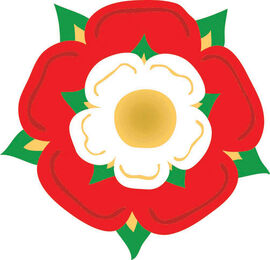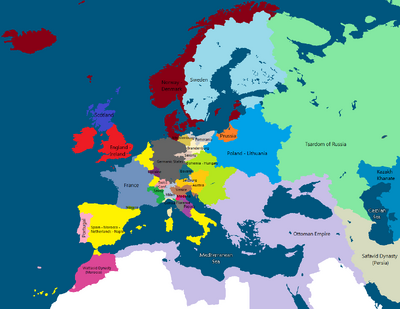
Tudor Rose
Tudor Line is an alternative history in which Henry, Duke of Cornwall, third son of Henry VIII and Catherine of Aragon survives and becomes King Henry IX. This timeline lessens the reformational process in the Holy Roman Empire, as the Catholic faith is more unified without Henry declaring himself the head of a new faith. In fact, this Henry VIII is called defender of the faith by Pope Leo X.
Timeline[]
- The timeline is currently being edited and changed, it will be done in a few days.
Map and Countries[]

Europe, 1550
- Kingdom of England -Henry IX
- Kingdom of Scotland - Robert IV
- Kingdom of France - Francis II
- Kingdom of Spain - Joanna I
- Kingdom of Portugal - John III
- Kingdom of Navarre - Henry II
- Holy Roman Empire - Charles V
- Archduchy of Austria - Charles V
- Papal States - Innocent IX
- Duchy of Florence - Cosimo I
- Republic of Genoa - Gaspare Bracelli
- Duchy of Milan - Giovanni I
- Duchy of Savoy - Charles III
- Duchy of Lorraine - Charles III
- Republic of Venice - Francesco Donato
- Republic of the Swiss
- Archbishopric of Salzburg - Ernest of Bavaria
- Duchy of Bavaria - William IV
- Electorate of Saxony - John Frederick I
- Margraviate of Brandenburg - Joachim II Hector
- Electoral Palatine (not on the map) - Louis VI
- Duchy of Mecklenburg - John Albert I
- Duchy of Pomerania - Barnin XI
- Kingdoms of Denmark and Norway - Christian III
- Kingdom of Sweden - Gustav I
- Kingdoms of Hungary and Bohemia - Casimir I
- Kingdom of Poland and G. D. of Lithuania - Sigismund II
- Ottoman Empire - Suleiman the Magnificent
- Duchy of Prussia - Albert I
- Teutonic Knights (already collapsed on the map) - Walter von Cronberg
Eastern Europe and Middle East
- Tsardom of Russia - Ivan IV
- Crimean Khanate - Devlet I
- Safavid dynasty -Tahmasp I
- Khiva Khanate - Haji Muhammad I
- Kazakh Khanate - Khak-Nazar Khan
- Siberian Khanate - Murtaza
America[]
- Spanish Empire - Ferdinand I
- English America - Henry IX
- Scottish America - Robert IV
- Lutheran Papacy - Sixtus VI
- New Caledonia - Robert IV
Western Africa[]
- Kingdom of Morocco - Joanna I
- Wattasid dynasty - Abu al-Abbas Ahmad ibn Muhammad
Asia[]
- Ming Dynasty - Longqing Emperor
- Kingdom of Great Joseon - Seonjo of Joseon
Thinking of the age[]
England[]
The early signs of Renaissance in England are probably the literally work of Thomas More. In 1521 he published his History of King Richard III, which received mixed acceptance, as it seemed to be a satire on aristocracy in general, rather then Richard and thus Henry VIII wasn't pleased. However, he pleased the king by co-writing Assertion and thus giving Henry the Defender of Faith nickname by Pope Leo X. However, this insulted Martin Luther and until 1525 they were in a sort of insult war, during this time Responsio ad Lutherum was written. He slowly turned more and more towards religion. Around the same time there were two composers. John Tavener became the first Organist in a church by 1526 and began writing masses and motets. At the same time Thomas Tallis became Henry VIII's composer and by his death in 1542 Thomas made over 200 songs, Henry IX, however, sacked him later on.
France[]
Charles VIII imported renaissance, but Francis I took this to a new level. He was a patron of arts and building in the style of the French renaissance. He invited Leonardo da Vinci, who actually lived in his court for the last 3 years of his life. Soon many French-borne borrowed Italian elements. There was a novel writer François Rabelais, whose novel are still understood on modern OTL, there was a painter Jean Clouet, who painted Francis I (used on his page). He also supported the poet Joachim du Bellay and building of many palaces. This building fever was continued after tuberculosis killed him by Francis II, who made his summer home in his honour.
Holy Roman Empire and Spain[]
The elements can be traced to the 14th century, but only with Maximilian I, Holy Roman Emperor did the spirit came to HRE. Eventually it got mixed up with the Gothic and religious rebellion, especially with Charles V and Martin Luther. The two renaissances of HRE and Spain became connected as Albrecht Dürer and El Greco became the most important artists and Humanism spread throw the teaching of Johann Reuchlin.
The Papal States[]
Since the Sistine Chapel Michelangelo served under the Popes and he got the job to make the Laurentian Library in 1524, there he used the predecessor of the Baroque style (Mannerism). The rest of his life was spend building St. Peter's Basilica.
